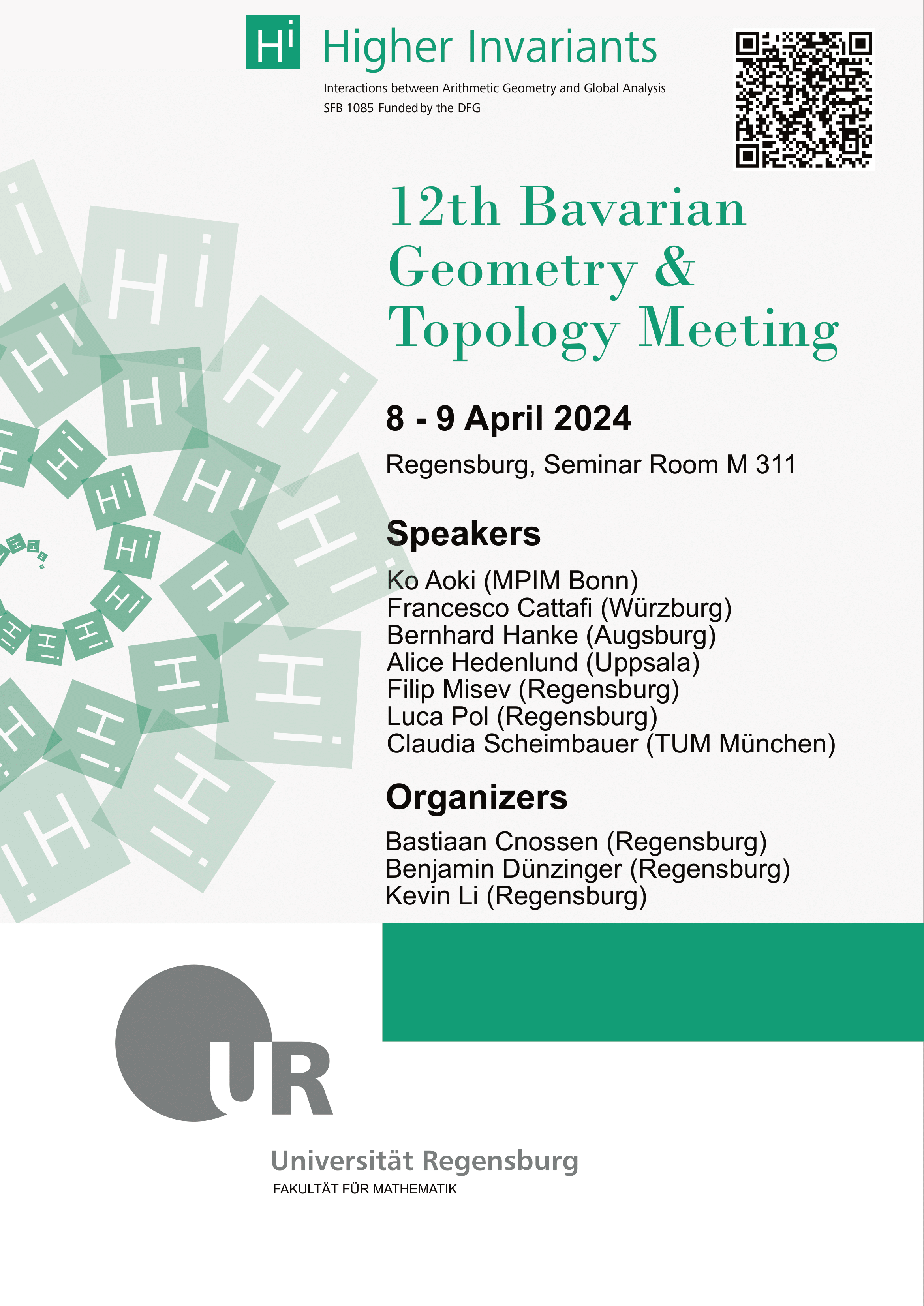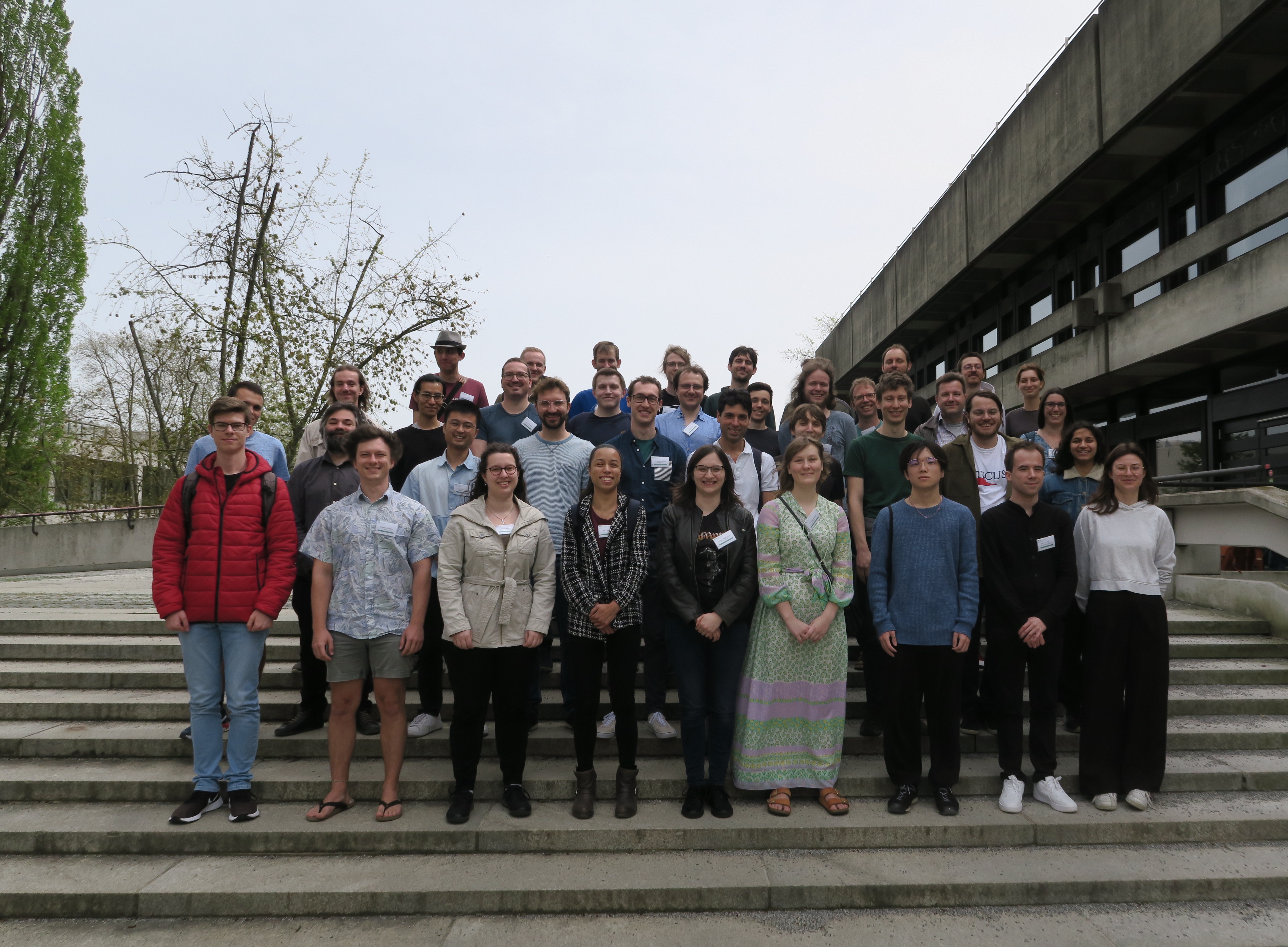

HomeAboutPeopleEventsResearchRTGGuest ProgrammeImpressum
12th Bavarian Geometry & Topology Meeting
Date and Location
The Bavarian Geometry & Topology Meeting XII will take place on 08-09 April 2024 at the University of Regensburg.
All talks will take place in room M311 on the 3rd floor of the Mathematics building of the University of Regensburg. (Attention: not the department "Mathematik und Informatik" of the OTH Regensburg).
Talks
Speakers:
- Ko Aoki (MPIM Bonn)
- Francesco Cattafi (Würzburg)
- Bernhard Hanke (Augsburg)
- Alice Hedenlund (Uppsala)
- Filip Misev (Regensburg)
- Luca Pol (Regensburg)
- Claudia Scheimbauer (TUM München)
Short Presentations:
- Divya Ghanshani (Regensburg)
- Thorsten Hertl (Freiburg)
- Andreas Huber (Augsburg)
- Rosa Marchesini (Göttingen)
Schedule
| Monday 08 April | Tuesday 09 April | |
|---|---|---|
| 10:00 - 11:00 | Francesco Cattafi | |
| 11:00 - 11:30 | Coffee break & Registration | Coffee break |
| 11:30 - 12:30 | Luca Pol | Ko Aoki |
| 12:30 - 14:00 | Lunch | Lunch |
| 14:00 - 15:00 | Bernhard Hanke | Filip Misev |
| 15:00 - 15:30 | Coffee break | Coffee break |
| 15:30 - 16:30 | Alice Hedenlund | Claudia Scheimbauer |
| 16:30 - 16:45 | Break | |
| 16:45 - 17:45 | Contributed talks | |
| 19:00 - End | Conference dinner at
"Weltenburger am Dom" |
Abstracts
Ko Aoki: Some recent progress on algebraic versus topological K-theory
For nice topological algebras, we have both algebraic K-theory and topological K-theory. Although algebraic K-theory is typically uncontrollable, it is believed to share nice properties with topological K-theory in certain situations. In my talk, I will highlight why these parallels are interesting and how Clausen–Scholze's condensed mathematics is useful to study them. In addition, I will discuss (partial) solutions to conjectures of Rosenberg. I will keep the talk accessible by avoiding technical details and not assuming any prior knowledge of algebraic K-theory or condensed mathematics.
Francesco Cattafi: Frame bundles of Lie/VB-groupoids
It is well known that the collection of linear frames of a smooth $n$-manifold $M$ defines a principal $GL(n,\mathbb{R})$-bundle over $M$ (called the frame bundle); more generally, this construction makes sense for any vector bundle over $M$. Conversely, any principal bundle together with a representation induces an associated vector bundle; these processes establish therefore a correspondence between vector bundles on one side, and principal bundles with representations on the other side.
If instead of a manifold $M$ we begin with a Lie groupoid $\mathcal{G} \rightrightarrows M$, one can consider both the frame bundles of $\mathcal{G}$ and of $M$ and try to "close" the resulting diagram in a natural way. The frame bundle of $\mathcal{G}$ is however too big to support a Lie groupoid structure over the frame bundle of $M$.
In this talk, after recalling the notions mentioned above, I will discuss how to fix this issue by introducing a special class of frames which interact nicely with the groupoid structure. Moreover, I will sketch how to generalise this construction to a correspondence between VB-groupoids (groupoid objects in the category of vector bundles) and PB-groupoids (groupoid objects in the category of principal bundles).
This is joint work with Alfonso Garmendia.
Bernhard Hanke: Torsion obstructions to positive scalar curvature
In 1998, Thomas Schick discovered a purely homological obstruction to the existence of positive scalar curvature metrics on oriented closed smooth manifolds in terms of torality properties of their fundamental classes. We will combine this obstruction with the enlargeability obstruction to positive scalar curvature metrics introduced by Gromov and Lawson in the 1980s.
As an application we construct new examples of manifolds which do not admit positive scalar curvature metrics, but whose Cartesian products admit such metrics.
Several fundamental questions remain open. The most important is whether toral manifolds of dimension at least 4 with finite fundamental groups of odd order admit positive scalar curvature metrics.
This talk is based on joint work with Misha Gromov.
Alice Hedenlund: Twisted Floer Homotopy Types From Seiberg-Witten Floer Data
In the 90s, Cohen- Jones, and Segal asked the question of whether various types of Floer homology theories could be upgraded to the homotopy level by constructing stable homotopy types encoding Floer data. They also sketched how one could construct these Floer homotopy types as (pro)spectra in the situation that the infinite-dimensional manifold involved is “trivially polarized”. It has since been realized that the correct home for Floer homotopy types, in the polarized situation, is twisted spectra. This is a generalization of parametrized spectra that one can roughly think of as sections of bundles of categories whose fibre is the category of spectra.
The aim of this talk is to give an introduction of Floer homotopy theory and twisted spectra. I will also outline the construction of a circle equivariant twisted spectrum from Seiberg-Witten Floer data associated to a 3-manifold equipped with a complex spin structure. As there are many moving parts to this (Atiyah-Singer index theory, finite-dimensional approximation, Conley index theory etc.), I will try to keep the talk on a conceptual level that will hopefully be accessible to a large audience. This is joint work in progress with S. Behrens and T. Kragh.
Filip Misev: On the unknotting number and the genus
While these two classical knot invariants, the unknotting number and the Seifert genus, are both easy to define, the former is incomparably harder to compute than the latter. They are incomparable in their values, too: there exist knots of small unknotting number and large genus and there are knots for which the unknotting number is larger than their genus. For many knots, however, their values actually coincide. This includes all positive braid knots, which in turn contain all algebraic knots, that is, connected links of plane curve singularities. It was conjectured by Stoimenow that equality between unknotting number and genus holds for the larger set of fibred positive knots. I would like to discuss the problem of determining the unknotting number for these knots, on one hand by example of some old and new unknotting algorithms, and on the other hand by presenting an infinite family of knots that seem to challenge Stoimenow's conjecture. Joint work with M. Kegel, L. Lewark, N. Manikandan, L. Mousseau, and M. Silvero.
Luca Pol: Global cohomology theories and applications
The study of cohomology theories defined on equivariant spaces has long been a key aspect of algebraic topology. In recent years it has become increasingly clear that many interesting cohomology theories defined on equivariant spaces admit the additional functoriality which characterizes a cohomology theory defined on topological stacks. Such cohomology theories are often refer to as global and prominent examples include Borel cohomology, complex K-theory and bordism. As often is the case in equivariant homotopy theory, we are more interested in "genuine" global cohomology theories which are in turn represented by global spectra. In this talk I will present conditions under which a global cohomology theory is represented by a global spectrum. As an application we will see that tempered and elliptic cohomology all admit global spectra. This talk is based on joint work with David Gepner and Sil Linskens.
Claudia Scheimbauer: Semiadditivity in higher categories and its application to topological field theories
I will start with recalling the classical notion of semiadditive categories and its generalization called “m-semiadditivity” of \infty-categories. Then we will discuss its application to constructing finite gauge theories as topological field theories following Freed-Hopkins-Lurie-Teleman and Harpaz. Finally, I will discuss a (even) higher categorical version thereof, namely an (\infty,k)-categorical version. This uses a loop-deloop adjunction for m-semiadditive enriched categories. This is joint work in progress with Tashi Walde.
Conference Dinner
The conference dinner will take place on Monday 19:00 at the restaurant Weltenburger am Dom.
Registration & Financial Support
The registration is closed.
We ask participants to organize an accommodation by themselves. The deadline to apply for financial support has passed.
Practical Information
DIRECTIONS: One can reach the University of Regensburg by following the instructions here and see here for maps of the campus.
INTERNET: Access to eduroam and BayernWLAN is available throughout the Mathematics Building.
ACCOMMODATION: Here is a list of hotels in the area:
- Hotel Muenchner Hof (City center)
- Hotel Apollo (Near University, far from city center)
- Hotel Kaiserhof am Dom (City center)
- Hotel Jakob (City center)
- Hotel Wiendl (Between city center and University)
- Hotel Central (Between city center and University)
Previous iterations of the BGTM
- 11th BGTM (LMU München)
- 10th BGTM (Augsburg)
- 9th BGTM (online)
- 8th BGTM (online)
- 7th BGTM (online)
- 6th BGTM (Augsburg)
- 5th BGTM (Regensburg)
- 4th BGTM (Augsburg)
- 3rd BGTM (Regensburg)
- 2nd BGTM (Augsburg)
- 1st BGTM (Regensburg)
Conference Poster
You can download the conference poster here.
Conference Picture
Organizers
- Bastiaan Cnossen (Regensburg)
- Benjamin Dünzinger (Regensburg)
- Kevin Li (Regensburg)

